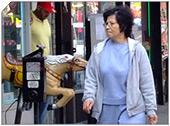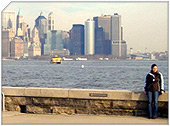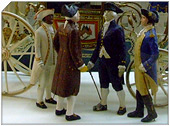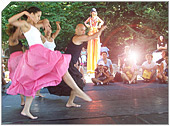Chelsea, Manhattan, New York City
|
Getting Started
Index
NYC Neighborhoods
Manhattan
Brooklyn
Queens
Bronx
Staten Island
NYC Icons
Chrysler Building
Flatiron Building
Empire State Building
Safe NYC
NYPD
FDNY
NYC Weather
NYC Climate
NYC Weather Forecast
Winter Season
Spring Season
Summer Season
Fall Season
NYC History & Politics
New York City History
Tammany Hall and Politics
New York City Politicians
New York City Personalities
Culture of Gotham City
Culture of the city
Cultural diversity
City in popular culture
|
Alphabet City, formerly considered a slum, is now a trendy part of the East Village in the New York City borough of Manhattan. Its name comes from Avenues A, B, C, and D, the only avenues in Manhattan to have single-letter names. It is bordered by Houston Street to the south and 23rd Street to the north where Avenue C ends. However, the historic boundaries of the Lower East Side - which transformed into the modern-day Lower East Side and Alphabet City - place the northern border at 14th Street. Some famous landmarks include Tompkins Square Park, the Nuyorican Poets Cafe and the Stuyvesant Town private residential community.
History
Chelsea takes its name from the Federal-style house of the Moore family, named after the manor of Chelsea, near London, which was home to Sir Thomas Moore. The house was the birthplace of Clement Clarke Moore, who is more often credited with "A Visit From St. Nicholas"- which he may have authored- than with the first Greek and Hebrew lexicons printed in the United States, which he certainly authored.
"Chelsea" stood surrounded by its gardens on a full block between Ninth and Tenth Avenues south of 23rd Street until it was replaced by high quality row houses in the mid-19th century. The former rural charm of the neighborhood was tarnished by the freight railroad right-of-way of the Hudson River Railroad, which laid its tracks up Tenth and Eleventh Avenues in 1847 and separated Chelsea from the Hudson River waterfront. Clement Clarke Moore gave the land of his apple orchard for the General Theological Seminary, which built its brownstone Gothic tree-shaded campus south of "Chelsea."
By 1900, the neighborhood was solidly Irish and housed the longshoremen who unloaded freighters at warehouse piers that lined the waterfront and the truck terminals integrated with the raised freight railroad spur. The film On the Waterfront (1954) recreates this tough world, dramatized in Richard Rodgers' 1936 jazz ballet Slaughter on Tenth Avenue.
Chelsea was an early center for the motion picture industry before World War I. Some of Mary Pickford's first pictures were made on the top floors of an armory building on West 26th Street.
London Terrace was one of the world's largest apartment blocks when it opened in 1930, with a swimming pool, solarium, gymnasium, and doormen dressed as London bobbies.
Traditionally, Chelsea was bounded by Eighth Avenue, but in 1883 the apartment block, soon transformed to Hotel Chelsea helped extend it past Seventh Avenue and now it runs as far east as Broadway. The neighborhood is primarily residential with a mix of tenements, apartment blocks and rehabilitated warehousing, and its many businesses reflect that: ethnic restaurants, delis and clothing boutiques are plentiful. Tekserve, the vast computer repair shop that strongly influenced Apple's Retail Store and Genius Bar concept, serves nearby Silicon Alley and the area's large creative community. Chelsea has a large gay population, stereotyped as gym-toned "Chelsea boys." Since the mid-1990s, Chelsea has become a center of the New York art scene, as an increasing number of art galleries have moved there from SoHo.
Most recently, Chelsea has become an alternative shopping destination with Barneys CO-OP, Comme Des Garcons, and Balenciaga boutiques. As well as being nearby Alexander McQueen, Stella McCartney, Christian Louboutin, etc.
|
New York City Search
Quick NYC
|
|
|
 How safe is New York City?
How safe is New York City? Contrary to popular belief, the City consistantly ranks in the top ten safest large cities in the United States. The NYPD is the largest municipal police force in the world and has it's own Movie/TV Unit. |

New York has a humid continental climate resulting from prevailing wind patterns that bring cool air from the interior of the North American continent. New York winters are typically cold with moderate snowfall.  New York Weather Forecast New York Weather Forecast |

New York's two key demographic features are its density and diversity. The New York City metropolitan area is home to the largest Jewish community outside Israel. It is also home to nearly a quarter of the nation's South Asians, and the largest African American community of any city in the country.  Ethnic composition Ethnic composition |

New York Newspapers
 
|



 New York Weather Forecast
New York Weather Forecast
 Ethnic composition
Ethnic composition


















